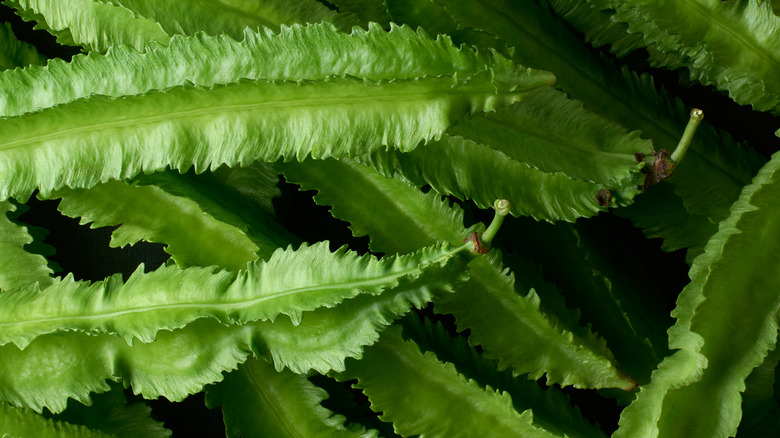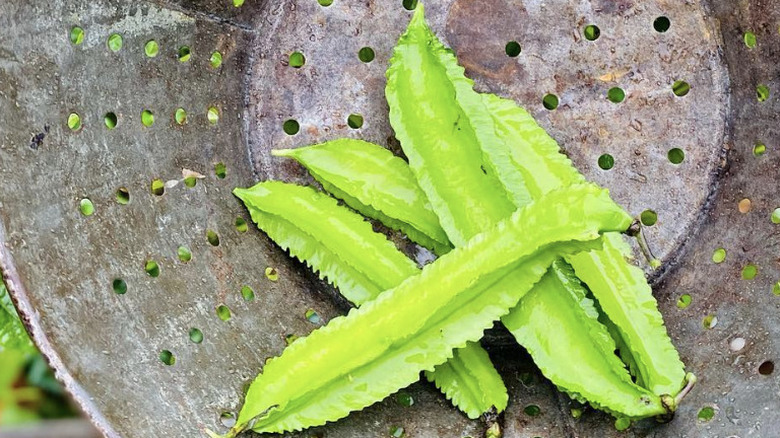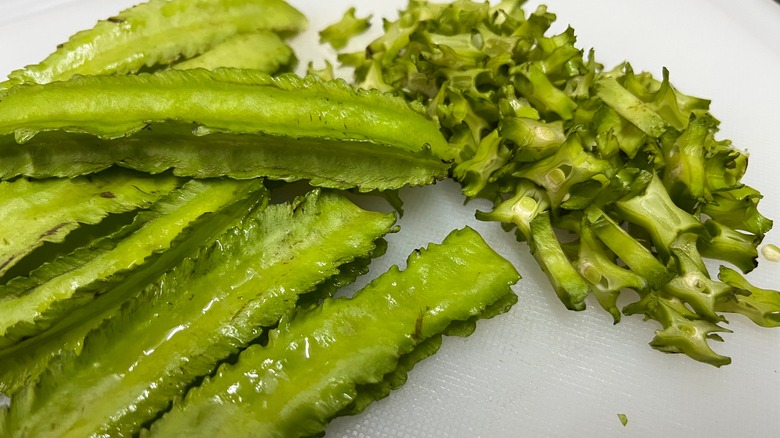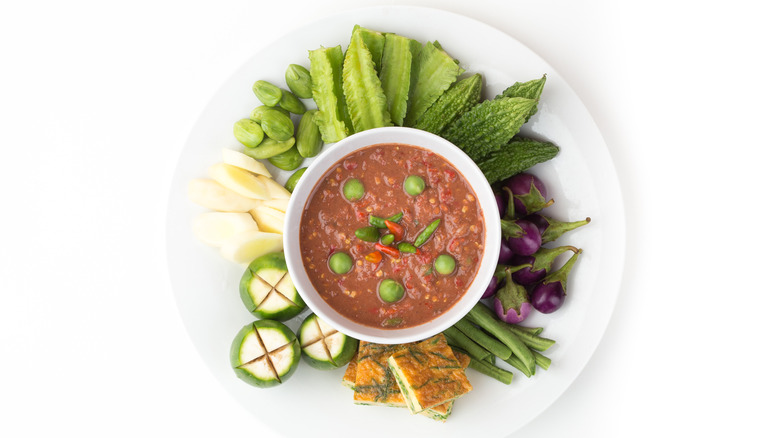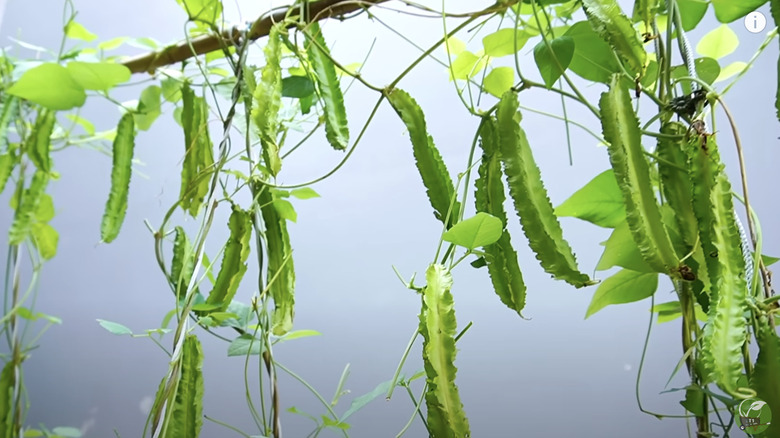What Are Vietnamese Dragon Beans And How Do You Cook Them?
Who can resist a name like Vietnamese dragon beans? As intriguing as the moniker may be, these snappy spring-green edible beans have nothing to do with fire-breathing dragons or fantastical fairy-tale bean stalks. But these exotic legumes do add an element of adventure to your dinner plate, especially considering the curious shape, flavor, and diverse edible applications.
Dragon beans (Psophocarpus tetragonolobus), commonly referred to as winged beans, get their name from the obviously dragon-like spikey contours and showy winged edges. In the Vietnamese language, the label is "dau rong," but this showy bean takes on other colorful regional names across the Asian continent, including kacang botol in Malaysia and shikaku-mame in Japan.
More colloquial epithets range from goa to four-angled beans, princess and Mauritius beans, cigarillas, and winged or asparagus peas. When cooking dragon beans, you'll find lots of inspiration and ideas from regions in which they've thrived for generations, especially Vietnam, Indonesia, Thailand, and Malaysia.
What is a Vietnamese dragon bean?
The Vietnamese dragon bean is a tropical species residing in the Fabaceae botanical family. Each bean hosts four vertical "winged" sides and typically presents in verdant spring-green hues. Some varietals veer toward purplish-red or even ivory tones. At peak freshness, the pods have a firm, waxy, smooth texture. Avoid purchasing ones that are soft, turning yellow, or have an excess number of brownish-black blemishes.
The herbaceous plant thrives in warm, humid climates, and the bean pods dangle from tangled vines, typically spanning a length of up to 13 feet. The pods themselves average about 4 inches at harvest time but can continue growing to 12 inches or more.
Home chefs new to winged-bean cooking usually start with stir-fries, soups, curries, and salads before customizing them for their own kitchens. To make the endeavor even more enticing, the entire plant is edible — that means the expected bean pods and the flowers, seeds, stems, and leaves.
What do dragon beans taste like?
The flavor of winged beans is typically earthy, mild, and subtle, with hints of sweetness. Many fans of this legume liken it to the taste and crispness of fresh asparagus and sometimes snap peas, which can work as a substitute in recipes. The peak flavor and crisp texture reach their full potential when harvested early, at about 2 to 4 inches long. If left on the vine to mature longer, the interior seeds can cause indigestion, so they must be cooked before being consumed in dried, roasted, or powdered form.
When sautéing the bean pods, you don't want to cook them too long, as they can turn bitter and become limp after two to three minutes. The edible flowers of this plant have a light, airy taste, while the tubers when roasted or baked, release a warm, nutty flavor profile. The somewhat neutral-tasting leaves can be steamed but also blend well into salads, similar to spinach.
Cooking with dragon beans
Versatility is the name of the game when cooking dragon beans. In fact, you don't even have to cook them at all. They're equally delicious as a snack food or appetizer, eaten crunchy and raw with dips or sauces, accompanied by other vegetables such as celery, carrot sticks, jicama, or new-to-you Asian edibles. When sliced, they work well as a snappy textural addition to salads. Just slice them diagonally, chop them to your desired length, and toss them in. Be sure to wash them first and trim off the ends.
Many chefs recommend stir-frying winged beans, traditionally accompanied by fish sauce in Vietnamese recipes, along with other vegetables such as scallions and garlic and a squeeze of lemon or lime juice. You can also simply add seasonings and steam or boil them, sauté on the stovetop, bake them in the oven, fry them into tempura dishes, or smoke them on the grill. The beans serve as an excellent textural component in curries, dahls, and stews or soups.
Then there are the other edible parts of this multi-faceted pole bean. The delicate lavender-hued flowers work well as a side dish when lightly sautéed. They add a dash of color to rice, potatoes, or to the plant's own tubers, which supply a potato-like starch with nutty undertones. Any seeds remaining in the pods can be cooked and mixed with liquids to create a nutritious milky drink. It's also common for Vietnamese chefs to toss them into fried vegetable and fish dishes.
Where to find and how to grow dragon beans
Dragon bean pods grow on a trailing vine with fragrant flowers, typically available in the later spring months through autumn. Finding them can be a challenge, depending on where you live. Asian markets are your best bet due to the prevalence of winged beans in Asian-inspired cuisine. In hot, humid areas, you could also find them at farmers markets or specialty produce stores. They've been known to grow in the U.S. states of Hawaii, Florida, and even Texas, so supermarkets there are more likely to carry them when in season.
With careful tending, it's quite possible to grow these edible beauties in your own garden. Since the pods hang from climbing vines, you'll need a trellis to support them while they blossom and grow in full sun with moderate watering and well-drained soil. The time from planting to harvest typically ranges from 75 to 80 days. To get a jumpstart on the growing season, either start the seedlings indoors or pre-soak them to encourage early germination. DIY Garden Ideas offers some visual tips on growing dragon beans from seed to fruition (via YouTube).
Though grown commercially in only a few U.S. states, a home gardener can potentially be successful with these legumes across much of the country. If you end up with a surplus, these high-protein beans can be put to good use as fish bait or to supplement livestock feed.
Nutritional benefits of dragon beans
Despite being referred to as "poor man's food" in some circles because all its components can be used as food, dragon beans carry highly beneficial amounts of nutrition. According to MDPI, that includes vitamins, oils, plant proteins, and carbohydrates, and their ancient use as "medicinal plants" dates back to roughly 2600 B.C. In addition, they harbor a wealth of antioxidant, anti-inflammatory, and other health-enhancing properties.
The beans supply about 11.6 grams of protein per 3.5 ounces, with the root tubers alone comprising 20% protein. The leaves also harbor higher amounts of protein, up to 15%, compared to other leafy greens. Then there are the numerous amino acids and the highly beneficial amounts of fiber and minerals such as iron, manganese, and copper. As if that's not enough, the substantial amount of folate in winged beans is beneficial during pregnancy and can aid in maintaining brain health and regulating blood sugar, per Full of Plants.
